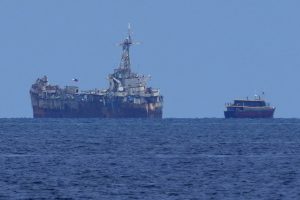Last night, the Financial Times published a report claiming that the Philippines has “secretly reinforced” the grounded warship at the center of its unfolding stand-off with China in the South China Sea – something that Beijing has long opposed.
Citing “six people familiar with the operation,” FT’s Demetri Sevastopulo reported that the Philippines “has conducted missions to reinforce the Sierra Madre,” a rusting warship that is grounded on Second Thomas Shoal, a low-tide elevation in the Spratly Islands. They have done so out of concern that the rusting ship is “in danger of breaking apart.”
The BRP Sierra Madre, a former U.S. warship that saw service during WWII, was purposely grounded by the Philippines in 1999 to help reinforce its claim to the shoal. The rusting vessel, which requires frequent missions to resupply the unit of marines living within it, has evolved into the most dangerous flashpoint in the South China Sea.
Over the past year, the China Coast Guard (CCG) has used increasingly violent tactics to block Manila from resupplying the outpost, including ramming its patrol vessels and supply boats and blasting them with high-pressure water cannons. On Monday, personnel from the two sides came to direct physical blows as CCG motorboats repeatedly rammed and then boarded two Philippine Navy rigid-hulled inflatable boats (RHIBs) seeking to resupply the Sierra Madre.
The CCG successfully prevented Filipino personnel from transferring supplies including food, fuel, M4 rifles, and navigation equipment. The Chinese personnel reportedly “seized the boats and damaged them with machetes, knives, and hammers.” According to Filipino media reports, a number of Filipino navy personnel were wounded in a melee aboard one of the RHIBs, including one who lost his right thumb.
While the FT described the reinforcement activities as “secret,” China has alleged something similar for some time. In justifying its recent aggressive actions, Chinese officials have accused Philippines supply ships of bringing construction materials to reinforce the vessel, violating an apparent earlier agreement, made by former President Rodrigo Duterte, that only basic supplies would be delivered to the marines stationed there. (Chinese officials have also referred to an earlier promise that the Philippines made to remove the ship from the shoal entirely, something that Manila denies.)
In early April, Harry Roque, who served as Duterte’s presidential spokesperson, told the press that Duterte had agreed informally with Beijing to observe the status quo in disputed waters. Part of this involved an undertaking that the Philippines would not send construction materials to repair the Sierra Madre. Duterte later confirmed the informal agreement. President Ferdinand Marcos Jr. says that his administration is not bound by informal agreements made by Duterte, and has vowed not to cede a “single inch” of territory to China.
In any event, the Philippines has denied carrying out any substantial construction activities on the warship in recent months, even though this would be well within its legal rights. Second Thomas Shoal lies within its Exclusive Economic Zone (EEZ), and its sovereignty over the area was recognized by a landmark arbitral ruling in 2016. At the same time, Beijing appears to view any construction activities aimed at creating a permanent outpost as something of a red line. The claims contained in the FT story could plausibly explain the aggression of the Chinese response in recent months.
However, the FT article did not detail when the reported missions took place, nor exactly what the Philippines had done to reinforce the vessel, except to say that Manila “had secretly reinforced the ship in ways that would extend its life.”
Since grounding the ship in 1999, the Philippines has reinforced parts of the structure in order to make it more habitable for the troops stationed there. In April, Frances Mangosing of The Inquirer, who was embedded on a resupply mission in 2022, recalled that the supply ship “carried construction materials such as angle bars, welding electrodes, and deck plates, aside from the food supplies.” At the time, Defense Minister Delfin Lorenzana said that “our personnel need to repair the living quarters, so you [China] cannot prevent us from repairing that.” The Philippines has also openly admitted conducting such activities in recent months, as tensions with China have grown, but has described them as “superficial repairs.”
Some observers are skeptical that more substantial repairs, such as those implied by the FT report, are possible, given the nature and advanced state of the ship’s decay. In a post on X, Collin Koh of the S. Rajaratnam School of International Studies in Singapore, argued that “you can’t reinforce the hull microstructures – metallic corrosion is simply irreversible.”
All of this leaves it uncertain whether the “reinforcement” described by the FT represents an evolution in Philippine policy – that is, a response to the recent Chinese pressure campaign – or merely the continuation of past practice.
Complicating the issue is the fact that “repair,” “reinforcement,” and “construction” are all open to a great deal of interpretation, as is the question of what exactly constitutes “superficial repair” work. This alone makes it hard to know exactly where China’s “red line” on Second Thomas Shoal lies, and whether the Philippines has transgressed it.
In any event, the situation may now have deteriorated to the extent that past handshake agreements, whatever their terms and legitimacy, have been superseded by events. As things stand, it is unclear if there is anything the Philippines can do to placate Beijing, aside from abandoning the Sierra Madre altogether.

































